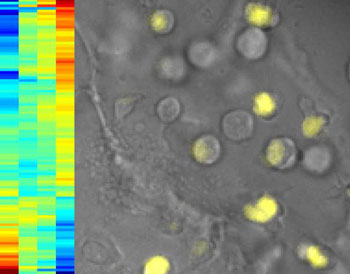Multitiered Molecular Control Mechanism Regulates T-cell Genetic Switch
By LabMedica International staff writers
Posted on 27 Jul 2016
Three distinct molecular processes act in a stage-specific manner to provide a multitiered system for regulating the T-cell developmental gene BCL11B (B-cell CLL/Lymphoma 11B).Posted on 27 Jul 2016
During T-cell development, multipotent progenitors commit to the T-cell lineage by turning on the BCL11B gene, which encodes a transcription factor. To identify the factors responsible for controlling the commitment mechanism, investigators at the California Institute of Technology (Pasadena, USA) followed developing T-cells at the single-cell level using mice genetically engineered to express a fluorescent protein in addition to their own Bcl11b protein. This caused the mouse cells to glow under the fluorescent microscope when the BCL11B gene was activated.

Image: Cells labeled to identify proteins that regulate the expression of a genetic switch for T-cells. On the right, T-cells where the switch is activated glow in yellow. On the left, the rainbow pattern, a hierarchical cluster analysis, tells investigators which genes are controlled by the switch. The horizontal stripes are the genes. If they stripes turn red going from left to right, it means they are turning on; if they turn blue, the genes are turning off (Photo courtesy of the California Institute of Technology).
Results published in the July 4, 2016, online edition of the journal Nature Immunology revealed that a group of four protein transcription factors cooperated in a series of multi-tiered steps to regulate the T-cell genetic switch.
Initially, the proteins HNF1 homeobox A (HNF1A; also known as TCF1) and GATA binding protein 3 (GATA3) performed an early locus "poising" function, which paved the way for the activation step. Next, Notch protein signaling activated BCL11B. The fourth protein, Runt-related transcription factor 1 (Runx1) controlled the amplitude of the signal.
"We identify the contributions of four regulators of BCL11B, which are all needed for its activation but carry out surprisingly different functions in enabling the gene to be turned on," said senior author Dr. Ellen Rothenberg, professor of biology at the California Institute of Technology. "It is interesting - the gene still needs the full quorum of transcription factors, but we now find that it also needs them to work in the right order. This makes the gene respond not only to the cell's current state, but also to the cell's recent developmental history."
Related Links:
California Institute of Technology













